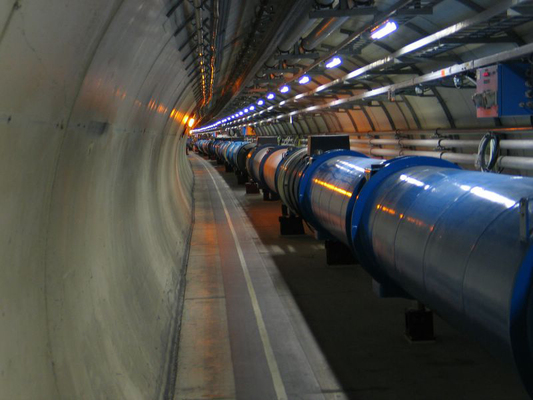
by Carolyn Gramling Thursday, January 5, 2012

The underground tunnel of the Large Hadron Collider accelerator ring, where the proton beams are steered in a circle by magnets. CERN
Tuesday, Sept. 9, 11:30 a.m. EDT — Fourteen years in the making, the $8 billion Large Hadron Collider comes online Wednesday at last (although, when you think about it, that's not really that long to wait for a machine that may reveal some of the mysteries of the universe).
The switch-on is provoking strong public reaction: Scientists are excited and eager to see what the LHC can do; alarmists are worried about the end of the world. And one person made a funny rap.
The huge collider, which is housed at CERN, the European Organization for Nuclear Research in Geneva, Switzerland, is basically a big, powerful particle-smashing machine. It works like this: An accelerator will excite subatomic particles to super-high energies (about 7 trillion electron volts). Those particles are then injected into the LHC, which contains the world's largest superconducting magnets. The magnets will control the particles' paths, forcing them to travel around a circular 27-kilometer-long tunnel (which is also 100 meters underground).
When two beams of particles that are traveling in opposite directions meet, they will smash together powerfully. Such a collision will shatter the particles, and the energy of the explosion will be converted to mass — and that's about the closest we can get to recreating the Big Bang.
Those collisions, scientists hope, will give insight into a lot of outstanding questions about the universe. Questions like: What holds the universe together? What's dark matter? And what became all of the antimatter that formed alongside matter during the Big Bang?
One thing scientists particularly hope to see is the elusive Higgs boson, an elementary particle whose existence has been predicted but has never been observed. That may sound arcane (okay, it is), but to physicists, this "God Particle" is a key missing link. Finding the Higgs boson would confirm a theory about how particles with little or no mass (like protons) can actually acquire mass. That gets at a fundamental question: We may know how massive the building blocks of matter — atoms — are, but we don't know why atoms have the masses that they do. So understanding how particles acquire their masses is, in effect, a step to understanding why the universe is the size it is. (Some better explanations of this by actual physicists are here.)
Although particles will first circulate through the entire tunnel on Wednesday, the high-energy collisions won't happen just yet. CERN scientists and engineers plan to run some pilot tests first; they want to make sure the magnets can handle the currents that will flow through them, which are required to produce the strong magnetic fields that can bend the paths of these high-energy particles. The first collisions are expected to happen on Oct. 28.
The LHC is hardly the first particle accelerator to look for these secrets (before the LHC, the biggest collider was the one at Fermilab outside of Chicago, Ill.). But LHC is by far the most powerful of its kind, and that's giving some people the heebie-jeebies, prompting them to call CERN to plead for reassurance that it's all going to be okay, or even to make death threats against its scientists.
What they're worried about are some hypotheses that the collisions, if they occur at high enough speed, can produce enough energy to spawn destructive "micro" black holes and/or exotic-sounding "strangelets" that would convert Earth's matter to odd microscopic lumps of "strange matter." (That's not unlike the sun-destroying "Q-balls" of the sci-fi movie "Sunshine"— which, probably not entirely coincidentally, had a science advisor from CERN).
But apart from science fiction, CERN scientists and other physicists scoff at arguments that the LHC might kill us all by creating black holes that will eat the world. In 1999, one scientific study took a look and found that the likelihood of micro black holes or strangelets being a danger from high-energy particle collisions is vanishingly small. And this year, a new CERN report on the dangers of the LHC pointed out that cosmic-ray collisions have produced higher energies a million times on Earth in its lifetime. And hey — we're all still here.
© 2008-2021. All rights reserved. Any copying, redistribution or retransmission of any of the contents of this service without the expressed written permission of the American Geosciences Institute is expressly prohibited. Click here for all copyright requests.